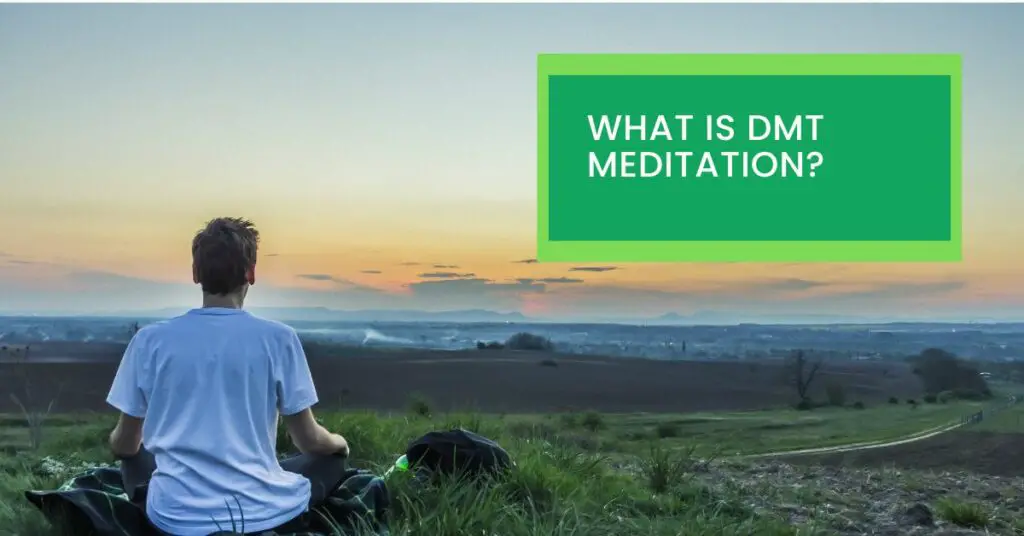DMT meditation is a relatively new concept in spirituality, gaining popularity amongst those seeking an alternative to traditional meditation practices.
What is dmt meditation? dmt meditation is a breathing technique that focuses on the release of DMT from the pineal gland. This is an extremely powerful psychedelic compound that produces intense auditory and visual hallucinations.
In this blog post, we will explore the basics of DMT meditation and how it can be used to enhance your spiritual journey.
Whether you are a seasoned meditator or just starting out on your spiritual path, learning about DMT meditation may provide you with new insights and experiences.
What Is DMT ? How DMT Is Produced ?
DMT, or N,N-Dimethyltryptamine, is a powerful psychedelic drug that occurs naturally in several plants and animals, including humans.
It produces a brief but immersive hallucinogenic experience that can have profound effects on consciousness and perception.
Despite being an illegal Schedule I controlled substance in the United States, DMT has a significant role in spiritual practices and shamanic rituals, where it is believed to provide a path for self-discovery and spiritual growth.
In recent years, the concept of DMT meditation has gained popularity, where individuals use mindfulness practices to harness the endogenous DMT in their bodies for profound insights and visuals.
Understanding the physiological effects of DMT and its potential for personal growth and healing can help individuals approach the practice of DMT meditation with more clarity and intention.
What Is DMT Used For?
DMT has been used for centuries by indigenous cultures as part of spiritual practices and shamanic rituals. In recent years, its use has expanded beyond these practices and has gained popularity within the psychedelic community.
DMT is known for producing profound, transformative experiences that can have long-lasting effects on a person’s perception and consciousness.
Additionally, DMT has been used to treat depression and anxiety, addiction, post-traumatic stress disorder (PTSD), and end-of-life anxiety in hospice patients.
While research on the therapeutic effects of DMT is limited, its potential to aid in the treatment of mental health disorders shows promise.
However, it’s important to note that DMT is still illegal and should only be used in controlled settings with experienced facilitators.
DMT’s Effects On Human Consciousness And Perception
DMT’s effects on consciousness and perception are highly sought after by those interested in spiritual exploration and personal growth.
The drug rapidly induces an immersive state of consciousness characterized by vivid visual and auditory hallucinations.
Research has shown that DMT can increase global functional connectivity in the brain, providing insights into the neural correlates of conscious experience.
However, DMT can also produce terrifying hallucinations and pose health risks, including psychological dependency.
For those interested in exploring the effects of DMT without using the drug, DMT meditation has become a popular practice.
This involves using meditation techniques to produce naturally occurring DMT in the body, potentially inducing similar effects on consciousness and perception.
While DMT can offer transformative experiences, it’s important to weigh the potential benefits against the risks before experimenting with the drug or meditation.
The Significance Of DMT In Spiritual Practices And Shamanic Rituals
The use of DMT in spiritual practices and shamanic rituals has a deep-rooted significance.
Shamans and spiritual leaders in ancient cultures have used the hallucinogenic properties of DMT-containing plants to enter into altered states of consciousness and connect with higher realms of existence.
The profound experiences induced by DMT have been reported to bring about a sense of clarity, insight, and a deeper understanding of oneself and the world around us.
In modern times, many individuals interested in spiritual growth have turned to DMT as a tool for exploration and self-discovery.
However, it is important to approach the use of DMT in a safe and responsible manner, with the guidance of experienced practitioners, as it can also have potential risks and side effects.
Overall, the significance of DMT in spiritual practices and shamanic rituals remains an intriguing area of study, as it continues to offer new insights and avenues for personal growth and transformation.
Is DMT Legal?
DMT is a Schedule I controlled substance in the United States, making it illegal to manufacture, buy, possess, or distribute.
However, as of 2022, DMT has been decriminalized in Vancouver, and several outlets openly sell it in various forms.
Though DMT has gained increasing media attention, it remains illegal in the US. It’s crucial to note that possession of DMT can lead to heavy fines or even imprisonment.
Therefore, one must be cautious when contemplating using DMT, and it’s best only to consume if it’s legal in their jurisdiction.
What Is DMT Meditation?
DMT meditation is a type of mindfulness meditation that is specifically designed to help people become more aware of the profound insights and visuals that can be experienced during a DMT trip.
It involves some specific breathing techniques that can help one produce a surge of endogenous DMT.
DMT meditation is an all-natural and safe way of accessing the psychedelic experiences related to DMT.
When approached responsibly, it can be used for personal growth, healing, and spiritual exploration.
It can help individuals to tap into their innate abilities and explore the full potential of their consciousness.
The practice of DMT meditation has been used for thousands of years by various cultures to calm themselves down, relax and meditate.
The following blog sections will dive deeper into what DMT is, and its effects on consciousness and perception.
How To Do DMT Meditation- How To Produce DMT Through Meditation?
To do DMT meditation, one must first understand that DMT is naturally produced in the human body, specifically in the pineal gland.
To enhance the production of DMT through meditation, one should focus on achieving deep states of relaxation and heightened awareness.
This can be done by practicing various meditation techniques, such as breathwork and visualization, and finding a quiet and serene environment.
It is important to note that while meditation can induce the production of DMT, it is not necessary for an individual to consume external sources of the substance to reach a spiritual state.
DMT meditation allows individuals to connect with their intuition and experience profound spiritual growth and healing while in a safe and controlled environment.
The Role of the Pineal Gland in DMT Meditation
The pineal gland is a small, pinecone-shaped gland located in the center of the brain.
It is responsible for the production of melatonin, a hormone that regulates sleep and wake cycles.
Through recent research, it has been suggested that the pineal gland may also play a role in the production of DMT, a powerful psychedelic substance.
DMT is believed to be produced in small amounts during dreaming and meditation, which can lead to profound transcendent experiences.
Therefore, the pineal gland is thought to be central in the process of DMT meditation.
By utilizing various meditation techniques, individuals can stimulate the pineal gland to produce greater amounts of DMT, leading to altered states of consciousness and potentially transformative experiences.
It has been proposed that the pineal gland, located in the brain, plays a significant role in this process.
The pineal gland excretes large amounts of DMT during mystical experiences and near-death experiences, which may explain the intense and otherworldly nature of DMT meditation.
However, it is important to approach DMT meditation with caution and understanding of the potential physical and emotional side effects.
How Does DMT Meditation Work?
DMT meditation works by stimulating the pineal gland to produce endogenous DMT.
This gland acts as the brain’s timekeeper and is responsible for regulating sleep-wake cycles.
During meditation, the pineal gland becomes active and secretes DMT, enhancing the meditation experience.
This elevated DMT level leads to heightened levels of awareness, facilitating a profound connection between the individual and the universe.
DMT meditation can lead to self-discovery, spiritual awakening, and healing.
When DMT is released from the pineal gland, it triggers visionary experiences, which bring buried emotions, suppressed desires, and unconscious thoughts to the surface.
These experiences can assist individuals in developing higher levels of consciousness and self-awareness.
However, it is essential to practice DMT meditation under the guidance of experienced practitioners to avoid potential side effects.
Overall, the practice of DMT meditation can transform an individual’s life by helping them achieve inner peace, gain personal insights, and connect with higher consciousness.
Does Breathwork Release the Psychedelic Spirit Molecule DMT in the Body
Breathwork has been suggested to release the powerful psychedelic molecule known as dimethyltryptamine (DMT) within the human body.
Rick Strassman, a researcher who conducted studies on DMT, named it the ” spirit molecule ” due to the intense and mystical experiences reported by participants in his research.
While DMT is produced naturally in trace amounts in the human brain, it remains unclear if the release of DMT through breathwork can significantly enhance psychedelic experiences.
Some theories suggest that the pineal gland, also known as the “ third eye ” may play a role in the production and release of DMT in the body.
However, current evidence does not support this idea.
The primary function of the pineal gland is the regulation of the sleep-wake cycle in the body through the production of the hormone melatonin.
Additionally, while some serotonin receptors may bind to DMT, the molecule does not activate these receptors in the same way as serotonin.
Therefore, it is unlikely that breathwork alone could release large amounts of DMT in the body.
However, some proponents suggest that breathwork may increase the blood flow to the pineal gland and other areas of the brain, possibly amplifying the effects of DMT that is naturally produced in the body.
Despite the limited scientific evidence, many people who practice breathwork or other forms of meditation report profound and transformative experiences that are often likened to those produced by DMT.
While the mechanisms underlying these experiences remain unclear, it is clear that breathwork can offer a powerful tool for personal exploration and transformation.
DMT Meditation Benefits – DMT Meditation for Personal Growth and Healing.
DMT meditation has numerous benefits for personal growth and healing.
By channeling the endogenous DMT in the human body, individuals are able to access altered states of consciousness that can help them develop a deeper understanding of themselves and the world around them.
Through DMT meditation, one can increase mental control and focus, alleviate anxiety and depression, and even heal from past traumas.
In addition to these psychological benefits, DMT meditation can also have physical benefits such as improved sleep, increased energy, and boosted immune system function.
With its ability to expand consciousness and facilitate personal transformation, DMT meditation is an incredibly powerful tool for those seeking to grow and heal.
Side effects of DMT Meditation
While DMT Meditation can offer profound spiritual experiences, it is important to be aware of the potential side effects.
These can range from physical symptoms such as increased heart rate and blood pressure, to mental and emotional effects such as anxiety and confusion.
It is important to approach DMT Meditation with caution and respect, and to ensure that the experience is taken in a safe and controlled environment.
It is also recommended to have a support system in place and to work with a trained facilitator or guide.
Despite the potential risks, many people find that DMT Meditation can offer unique insights and opportunities for personal growth and healing.
Physical side effects
DMT meditation has become popular because of the perceived spiritual experiences it provides.
However, like any psychoactive substance, DMT can cause physical side effects.
One effect is an increased heart rate and blood pressure, which can be dangerous for people with heart problems.
Other physical side effects of DMT include dilated pupils, nausea, and vomiting.
Furthermore, DMT can affect the respiratory system, leading to breathing problems and chest tightness.
While DMT is generally considered safe when used in a controlled environment, it is essential to be aware of its physical side effects before practicing DMT meditation.
It is recommended to consult with a healthcare professional before trying DMT meditation, particularly if you have any pre-existing health conditions.
Mental and emotional side effects
While DMT meditation can offer transformative experiences, it is important to note the potential mental and emotional side effects that may arise.
DMT’s ability to alter one’s perception can lead to intense emotional responses, including anxiety, fear, and paranoia.
However, these emotions can also create opportunities for personal growth and healing. Additionally, DMT meditation may cause a shift in one’s belief system and view of the world, leading to difficulties in integrating these new insights.
It is important to approach DMT meditation with caution and to prioritize mental health and stability before engaging in these practices.
It is recommended that individuals work with a trained professional to safely navigate the emotional and mental effects of DMT meditation.
What Is DMT Music ?
DMT music refers to a specific type of music that is played during DMT meditation.
This music is typically designed to create a specific frequency range that stimulates the pineal gland, which can help to increase the production of DMT in the brain.
DMT music is often composed of soft, repetitive sounds with a steady beat that helps the listener fall into a meditative state.
The music can also be used to guide the listener through specific visualizations or journeys that are meant to enhance the DMT experience.
While there is no one specific type of music that is used for DMT meditation, some common genres include ambient, downtempo, and psychedelic music. Overall, the goal of DMT music is to create a conducive environment for the listener to have a powerful and transformative experience.
DMT vs. Ayahuasca
DMT and Ayahuasca are both popular plant medicines known for their transformative effects on the mind and body.
DMT, or dimethyltryptamine, is a powerful hallucinogenic compound that is naturally produced by the human brain and can also be found in various plants.
Ayahuasca, on the other hand, is a plant-medicine that is made by combining the ayahuasca vine and a plant containing DMT.
Both DMT and Ayahuasca have been used for centuries by indigenous cultures for various reasons, including reducing stress, aiding with addiction, and helping to regulate mood.
However, Ayahuasca is a more complex plant medicine due to the presence of the MAO inhibitor, allowing the DMT to be orally active.
The combination of the ayahuasca vine and the DMT-containing plant increases the pH of the stomach, enabling the DMT to pass through the gut and into the bloodstream.
This method of ingestion also slows down the breakdown of DMT by monoamine oxidase ( MAO ), making the effects of Ayahuasca last significantly longer than those of DMT.
Despite their similarities, the differences in the way they are used and their chemical composition make DMT and Ayahuasca unique plant medicines with distinct properties and effects.
DMT Meditation Real Life Experiences
DMT meditation is an intriguing phenomenon that has attracted much attention in recent years.
Some practitioners claim that it provides a unique sensation of transcending, allowing them to explore realms beyond our physical world. According to a study published in the Journal of Psychopharmacology,
DMT meditation can induce powerful hallucinations and can be compared to near-death experiences.
Others believe that this practice has the potential to bring about profound shifts in consciousness, leading to a deeper understanding of the nature of reality.
Breathwork sessions change how a person feels and often involve deep breathing or other breathing techniques to bring about a state of relaxation and a sense of calm.
Some claim that it can be particularly helpful in highly stressful situations, like those encountered during an emergency or crisis.
Life force, the energy that animates all living things, is also believed to be affected by DMT meditation.
Practitioners report feeling a heightened sense of awareness and an increased connection to the world around them, which they attribute to the power of DMT meditation.
Overall, while the effects of DMT meditation are still a subject of debate, many people claim that this practice has had profound impacts on their mental and emotional well-being, as well as their sense of spirituality and connection to the universe.
Whether used alone or in combination with other techniques, DMT meditation continues to attract a devoted following who are eager to explore the deeper dimensions of human consciousness.
Conclusion
In conclusion, DMT meditation is a practice that incorporates the use of the naturally occurring psychedelic substance DMT to enhance the meditative experience.
While DMT has been shown to induce profound changes in consciousness, its therapeutic potential for mental illness and anxiety has not been conclusively proven.
However, DMT’s significance in spiritual practices and shamanic rituals cannot be denied.
The pineal gland seems to play a crucial role in producing DMT during meditation, and research suggests that frequent meditators may develop greater amounts of this substance naturally.
While there are reported cases of psychosis in individuals who indulge in excessive, unguided meditation, DMT meditation can also have beneficial effects on personal growth and healing.
Careful consideration and guidance are necessary for those interested in exploring DMT meditation, as it can have physical, mental, and emotional side effects.
Overall, more research is needed in this field to fully understand the potential benefits and risks of DMT meditation.
Best Wishes!
Read More
1.Benefits of Meditation for Depression











